In this article:
Actinic keratoses (AKs) are also called solar keratoses because they are caused by years of sun exposure. These skin lesions are precancerous, which means they have the potential to convert to skin cancer.
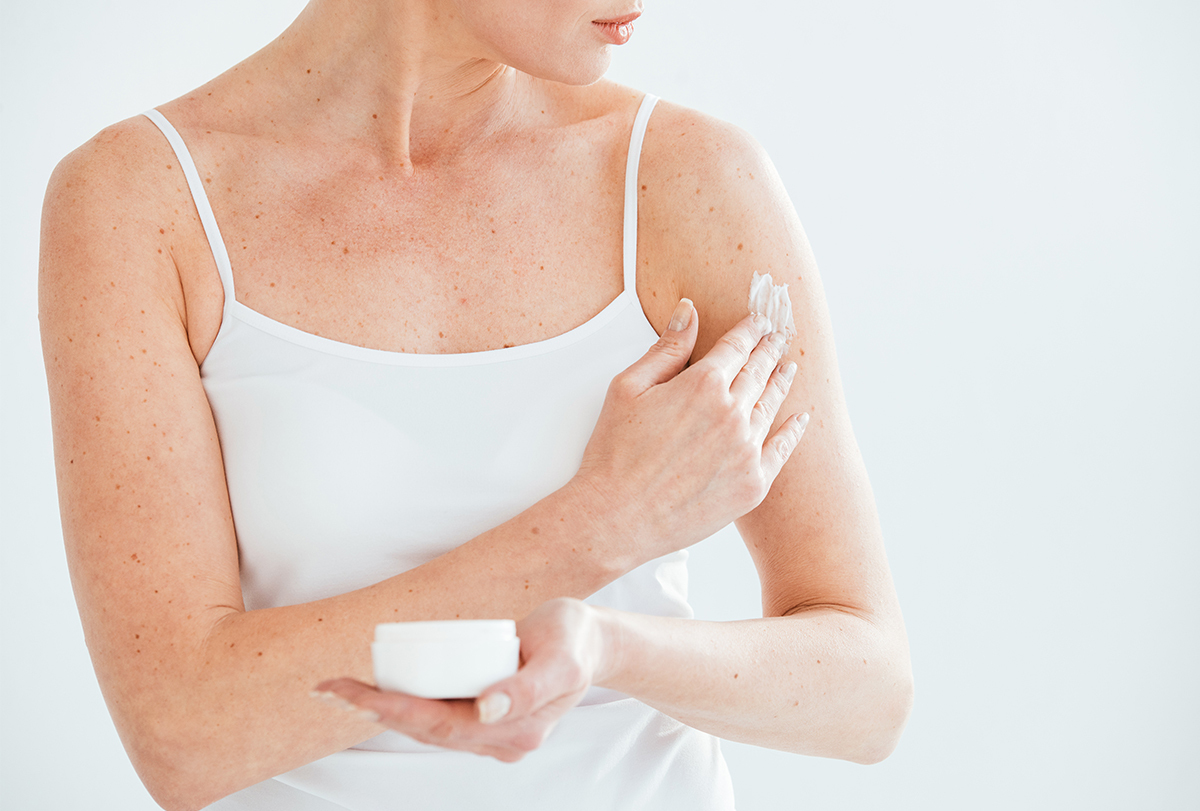
How Common Is This Condition?
AKs are a common dermatologic condition, being diagnosed in >10% of dermatology visits with over $1 billion in annual costs. (1) They are not usually found in children or young adults, but in middle-aged and older adults as it is a condition related to chronic sun exposure.
Where Do Actinic Keratoses Occur?
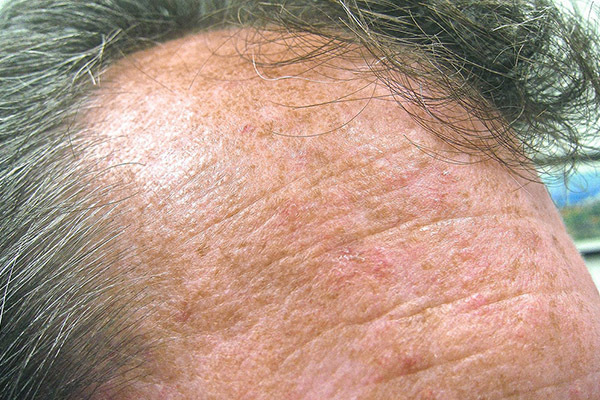
As AKs are related to chronic sun damage, they are predominantly found in the typically exposed areas of the skin that get the most sun, such as the face, scalp, ears, arms and hands, and lower legs (more frequently in women).
AKs can also occur on the lips with the same scaling quality, but when on the lips, this condition is called actinic cheilitis.
Causes of Actinic Keratoses (AKs)
Ultraviolet radiation (UVR) from the sun or indoor tanning is absorbed by the endogenous chromophores in the skin cells (keratinocytes such as DNA, melanins, and amino acids) and damages these structures to produce free oxygen radicals. These unstable molecules wreak havoc on other nearby cellular structures.
Once the DNA is damaged, permanent instability to the natural keratinocyte function ensues, leading to precancerous and cancerous states. An example of an exogenous (outside the body) chromophore is sunscreen, as it is meant to absorb the UVR to protect the skin from outside the body. (2)
Characteristic Features of Actinic Keratoses
Most AKs are:
- Rough
- Dry
- Scaly
- Very small to approximately the size of a quarter
- Skin colored, white, red, silvery, or brown, but with the rough scaling texture as a common feature
- Rapidly grow upward with a firm horn-like structure and are appropriately named “cutaneous horns” (3)
Medical Treatment for AKs
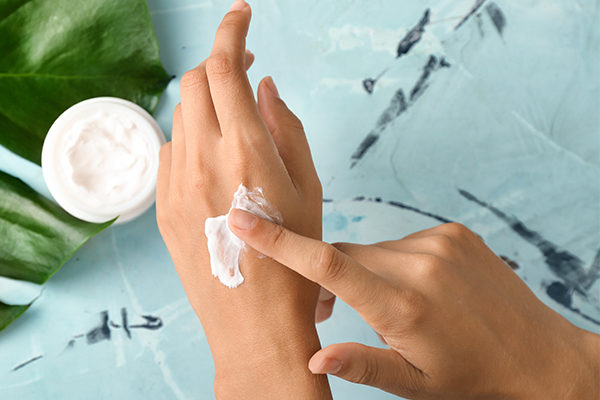
AKs can be treated in various ways.
1. Pinpoint (or lesion-directed) destruction
Lesion-directed therapy involves the destruction of AKs by cryotherapy using liquid nitrogen and is better suited for fewer (<10) lesions.
The application of cryotherapy will turn the skin red for the first 24 hours and then a blister will form. This inflammatory reaction and subsequent healing are thought to treat AKs. Risks of this procedure include pain, edema, infection, and permanent skin discoloration.
2. Field therapy (cream and/or light therapy)
There are many different types of field therapy:
- 5-FU cream
- Imiquimod cream
- Ingenol mebutate gel
- Photodynamic therapy (PDT)
There is no current agreement on the best field treatment for AKs. Each product comes with its own side effects, which can vary from patient to patient but generally include redness, pain, itching, irritation, flaking, and scaling.
3. Tretinoin
Another treatment is topical tretinoin. However, it has not been shown to have a consistent treatment benefit in the prevention of AKs. (4)(5)
You need to discuss the appropriate application method with your doctor before starting treatment, as each of these approaches has its own recommended application frequency and duration.
Diagnosing Actinic Keratoses
Because AKs are often light or skin-colored, they are not very noticeable and hard to diagnose through visual inspection. Instead, AKs are usually diagnosed by feeling the skin due to their rough texture.
AKs may be asymptomatic but can sometimes be itchy or painful with a raw feeling. The lesions can often resurface in the same spot after clearing. (4)
Home Remedies to Treat AKs
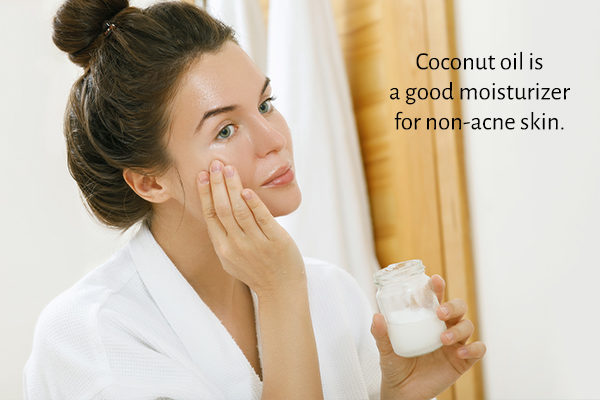
The following home remedies have become popular for the management of AKs. However, their efficacy is only supported by anecdotal evidence rather than scientific research.
1. Apple cider vinegar
Apple cider vinegar is well documented to have both antimicrobial and anti-fungal properties. (6) The acetic acid is thought to treat AKs by possibly interfering with cytokine and protein production.
2. Coconut oil
Coconut oil is a good moisturizer for non-acne skin, but its mechanism for AK treatment is unclear.
3. Green tea
Green tea (oral and topical) and tea tree oil have been reported to be of benefit. Several plant extracts have been tested in the treatment of AKs. Overall, the results have been lackluster, although two extracts did stand out as having some beneficial effects: birch bark and petty spurge.
- Birch bark was found to be more efficacious if used in the early treatment of AKs and, in fact, was found to be as effective as cryotherapy when treating lower-grade AKs. (7)
- Petty spurge (also known as milkweed) contains ingenol mebutate. Studies using this product found it to be highly effective against AKs compared to placebo, and scar formation was not noted. These studies were later confirmed in a double-blind, placebo-controlled study, and this gel was approved as a prescription drug in 2013. (8)
What Is the Difference Between Actinic Keratoses and Seborrheic Keratoses?
AKs are considered a precancerous condition, whereas seborrheic keratoses are common benign skin lesions.
Seborrheic keratoses are typically found in older adults, which is why they were once called senile keratoses, but the dermatological community did away with this terminology as it implied mental weakness as well.
Seborrheic keratoses are brown, grey, and white in color and tend to have a warty or “stuck-on” appearance. These lesions do not have malignant potential, but patients do tend to get more lesions with increased age.
Are Actinic Keratoses a Cancerous Condition?
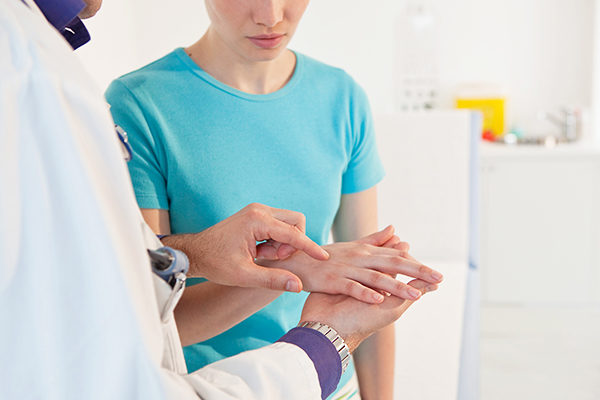
No, AKs are a precancerous rather than a cancerous condition. AKs may regress, stay stable, or turn cancerous. If they progress to skin cancer, they are the keratinocyte derivation of squamous cell carcinomas or basal cell carcinomas.
Although AKs have a relatively low progression rate to skin cancer (0.6% at one year and 2.57% at 4 years), they are often treated for both cosmetic and medical reasons. (9)
Final Word
Since AKs are mainly caused by prolonged sun damage, it is necessary to shield your skin from the harmful UV rays of the sun.
Ultimately, the best treatment for AKs is prevention through proper sun protection, which primarily includes regular sunscreen application and wearing protective clothing when stepping out during the day.
If you do develop these lesions, early treatment is necessary to keep them from turning cancerous. In most cases, prompt medical treatment can successfully remove unwanted skin growth without any complications or health risks.
- Was this article helpful?
- YES, THANKS!NOT REALLY


